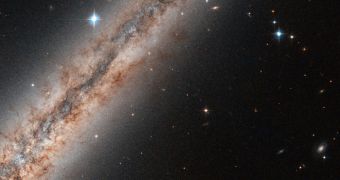Using the NASA/ESA Hubble Space Telescope, a team of astronomers was recently able to capture an impressive view of the edge-on, spiral galaxy NGC 891. The cosmic structure is located in the Andromeda Constellation, around 30 million light-years away from Earth.
The photo was collected using the wide-field Advanced Camera for Surveys (ACS) instrument, which is extremely well-suited for this type of investigations. NGC 891's bulge is located outside of this image, in the lower-left corner.
The galaxy is very similar to the Milky Way, since they are both around 100,000 light-years in diameter. However, NGC 891 differs through the fact that its plane contains gas filaments stretching outwards over distances reaching several hundred light-years. They can be seen here as well.
Supernova explosions or intense stellar formation are believed to be the main processes responsible for the formation of these gas filaments. In our own galaxy, new stars form at a relatively slow pace, so the likelihood of such filaments emerging is low.

 14 DAY TRIAL //
14 DAY TRIAL //